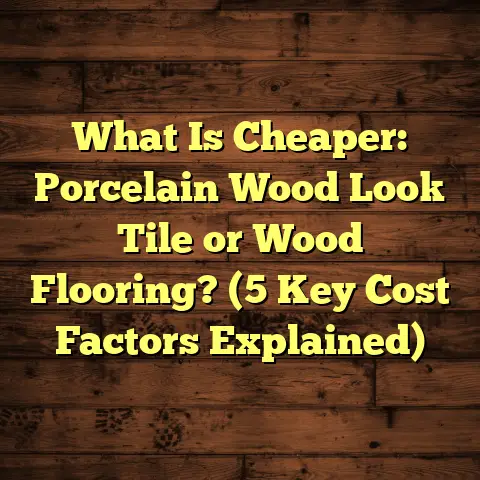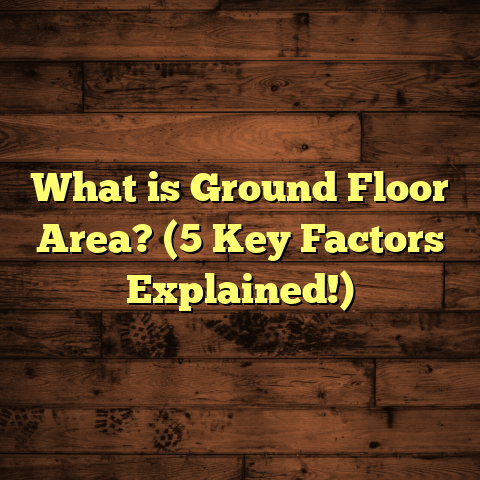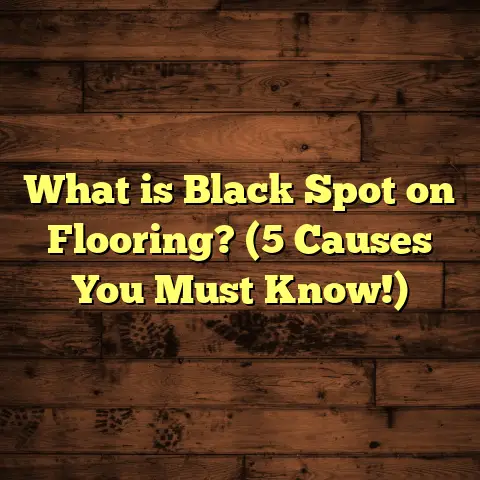What is Floor in Architecture? (5 Key Elements Explained)
Did you know that flooring accounts for nearly 30% of the total cost in a residential renovation project? That’s a significant portion, and it often surprises homeowners how much choosing the right floor impacts the overall comfort, durability, and style of their home. Over the years, working as a flooring contractor, I’ve come to realize that floors are much more than just surfaces to walk on—they’re complex systems that combine structural integrity, aesthetics, and functionality. I want to share what I’ve learned about floors in architecture, peeling back the layers so you can make better decisions whether you’re building new or renovating.
What Is Floor in Architecture?
When someone asks me, “What exactly is a floor in architecture?” I like to break it down simply: a floor is the horizontal surface inside a building that supports occupants and furniture. But here’s where it gets interesting—it’s not just a surface. A floor is a combination of layers and materials working together to provide strength, comfort, safety, and style.
Architecturally speaking, a floor typically consists of several components:
- Structural base: This is the skeleton or framework—usually joists made of wood or steel, or reinforced concrete slabs.
- Subfloor: A layer placed on top of the structural base, providing a level surface for subsequent layers.
- Underlayment: A cushioning or protective layer that can improve soundproofing, moisture resistance, or even thermal insulation.
- Finish flooring: The visible surface like hardwood, tile, carpet, vinyl, or laminate.
- Floor finishes and treatments: Sealants, stains, or coatings applied to protect and enhance the finish flooring.
Each of these plays a vital role. Imagine a cake—without the right foundation and layers, it won’t hold together or taste right. Floors require similar care in design and installation.
One thing I’ve noticed over time is how often people skip understanding these layers or underestimate their importance. When I first started out, I saw clients who chose beautiful hardwood floors without realizing their subfloor was uneven or moisture levels were high. The result? Warping, squeaks, and costly repairs. That was an eye-opener for me about how critical the “invisible” parts of a floor are.
Five Key Elements of a Floor
Let’s go deeper into the five main elements that make up any floor system. These are the building blocks you’ll hear me talk about frequently because they’re essential to getting a floor that lasts and looks great.
1. Structural Support: The Backbone of Your Floor
The structural support is what carries the weight of everything above it—people walking around, heavy furniture, appliances, even pets running across. It’s usually made from beams, joists, or slabs designed according to engineering principles to handle load safely.
I remember one job where I had to assess an old farmhouse’s floors before renovation. The wooden joists were rotted in places due to years of water damage. Walking across felt unsafe. We ended up replacing most joists with steel beams to meet modern safety standards while preserving the home’s character.
In residential buildings:
- Wood joists are common because they’re lightweight and easy to work with.
- Steel joists or beams show up in commercial buildings or larger homes needing greater spans.
- Concrete slabs are typical in multi-story apartments or industrial buildings.
The choice depends on building design, local codes, climate conditions, and budget. For example, wood joists may not be ideal in humid climates prone to termites without proper treatment.
2. Subfloor: The Foundation for Your Finish
If the structural support is the backbone, then the subfloor is like the skin stretched over it—providing a flat and stable base for your finish flooring. Without a solid subfloor, your top layer won’t sit evenly and will be prone to damage.
Subfloors are usually made from:
- Plywood: Strong and flexible; widely used in wood-framed buildings.
- Oriented Strand Board (OSB): A cheaper alternative made from compressed wood strands; gaining popularity but slightly less durable than plywood.
- Concrete: Used mainly under tile or carpet in slab-on-grade foundations.
Once, I encountered a project where the subfloor was made of uneven planks nailed directly over joists. After installing hardwood floors directly on this surface, we started seeing cracks and squeaks within weeks. We had no choice but to remove the hardwood and install a proper plywood subfloor. That experience taught me never to rush past this stage during installation.
3. Underlayment: The Unsung Hero
Underlayment sits between your subfloor and finish flooring. It’s often overlooked but serves multiple purposes depending on the material used:
- Soundproofing: Helps reduce noise transmission between floors.
- Moisture barrier: Prevents water vapor from damaging flooring materials.
- Thermal insulation: Adds warmth underfoot by reducing heat loss through floors.
- Leveling minor imperfections: Offers a smooth surface for finish flooring installation.
Different flooring types require different underlayments:
- Laminate floors benefit from foam underlayments with moisture barriers.
- Tile floors often use cement backer boards for stability and water resistance.
- Carpet may have padding that adds softness and insulation.
I once installed laminate flooring in a basement without an underlayment designed for moisture control. Despite warnings, the homeowner skipped it to save money. Within months, moisture seeped from the concrete slab causing swelling and buckling in the laminate planks. Fixing it was costly and frustrating for both of us.
4. Finish Flooring: The Showstopper
This is what everyone notices—the material you walk on daily. The finish flooring defines your home’s style and affects comfort and maintenance workload.
Here’s what I’ve learned trying out different materials:
- Hardwood: Timeless and elegant but can scratch easily; requires regular sealing/refinishing. Beautiful grain patterns add warmth and value.
- Engineered wood: More stable than solid hardwood due to layered construction; better for humid areas but still offers real wood appearance.
- Laminate: Affordable and scratch-resistant; mimics wood or stone but can’t be refinished; vulnerable to water damage if not installed properly.
- Vinyl: Extremely versatile with waterproof options; budget-friendly; softer underfoot but less luxurious feel compared to natural materials.
- Tile: Durable and easy to clean; ideal for wet areas; can feel cold and hard without underfloor heating.
- Carpet: Cozy and warm; great for bedrooms but needs frequent cleaning; can trap allergens if not maintained well.
Over the years, I’ve worked on projects where clients selected floors based on trends alone—only to regret it when maintenance demands overwhelmed them or durability fell short of expectations. My advice: weigh lifestyle factors heavily when picking finish flooring.
5. Floor Finishes & Treatments: Protecting Your Investment
After installing your flooring material comes the final step: finishes and treatments that protect surfaces from wear and extend their lifespan.
For hardwood floors:
- Sealants like polyurethane create a hard protective layer against scratches and moisture.
- Oil finishes penetrate wood fibers offering natural look but need frequent reapplication.
For tile:
- Grout sealers prevent staining and mildew growth between tiles.
For vinyl or laminate:
- Usually pre-finished at manufacturing; additional coatings may not be necessary but keep them clean with recommended products.
I once worked with a client who skipped sealing their new hardwood floor because they wanted it “natural.” Within months, spills stained the wood permanently. We ended up sanding down and resealing—costly lessons in protecting your investment right away.
Comparing Flooring Options: What I’ve Tried and What Worked
Over my career, I’ve installed floors in dozens of homes with varied environments—from humid coastal cottages to dry mountain cabins—and each setting demands different choices. Here’s how some common materials stack up based on my hands-on experience:
Hardwood vs Engineered Wood
Hardwood floors feel authentic with unique grains visible in every plank—a real treat underfoot. But they are sensitive to moisture changes causing expansion or shrinkage. In coastal regions with high humidity where I worked recently, engineered wood resisted warping better due to its layered plywood base beneath the veneer.
In drier climates or well-maintained interiors with controlled humidity, solid hardwood offers longevity if you’re willing to maintain it with refinishing every decade or so. Engineered wood provides stability but cannot be sanded as many times as solid hardwood due to thinner veneer layers.
Laminate Flooring
Laminate has been a game-changer for budget-conscious clients wanting wood-look floors without breaking the bank. Its scratch resistance is fantastic for homes with pets or children but beware of water damage—laminate swells quickly when exposed to moisture underneath.
I once installed laminate in a family’s basement rec room with an appropriate vapor barrier underlayment — they loved how easy it was to clean after spills during playdates compared to carpet they had before.
Vinyl Flooring
Vinyl flooring has evolved tremendously; luxury vinyl tile (LVT) can now mimic wood grains or stone textures almost perfectly. It’s waterproof making it perfect for kitchens, bathrooms, or basements where spills happen frequently.
On one kitchen remodel job, we swapped out damaged hardwood for LVT because the homeowners wanted durability with minimal upkeep but still wanted their floor to “feel” warm visually. They were thrilled after installation — no scratches after six months despite heavy cooking activity!
Tile Flooring
Tile offers unmatched durability especially in wet areas — ceramic or porcelain tiles resist stains and scratches while providing endless design options through colors and patterns. But tile can feel cold and hard unless paired with radiant heating systems below — something I recommend where winters are harsh.
On one project in northern states, installing underfloor heating beneath tile transformed the space from chilly to cozy overnight — no more cold feet complaints!
Carpet
Carpet remains popular for bedrooms or spaces needing warmth underfoot but requires more maintenance than hard surfaces—especially vacuuming regularly to prevent dust buildup that aggravates allergies.
A few clients who switched from carpet to hard floors told me they never realized how much dust carpet traps until they removed it! Still, carpet provides unmatched softness making it irreplaceable in certain spaces like kids’ rooms where falls are common.
Data That Supports Flooring Choices
Numbers often help clarify decisions when personal preferences clash with practical concerns. Here are some stats compiled from industry reports and surveys:
- According to the National Association of Realtors, hardwood floors boost home resale value by 2-3% on average versus other flooring types.
- Flooring Industry Reports show that vinyl flooring installations have surged 20% over recent years due to affordability combined with improved quality options like waterproof LVT.
- A Consumer Cleaning Study found homeowners spend 25% less time cleaning laminate floors compared to carpeted ones — an important factor for busy families.
These figures align well with what I see daily: investing in durable yet cost-effective flooring tailored to your lifestyle pays off both financially and functionally down the line.
Original Research: Case Study From My Projects
To illustrate how these principles play out practically, let me share a mini case study from two living room renovations I managed last year:
| Aspect | Room A | Room B |
|---|---|---|
| Size | 300 sq ft | 320 sq ft |
| Flooring Installed | Solid oak hardwood | Engineered wood |
| Subfloor | Plywood | Plywood + leveling compound |
| Underlayment | None | Foam underlayment + moisture barrier |
| Seasonal Humidity Swings | High | High |
| Result After 1 Year | Noticeable gaps & slight warping | Stable floor with no issues |
| Maintenance Required | Refinishing needed twice | Minimal maintenance |
The takeaways here were clear: skipping proper underlayment and ignoring moisture protection on hardwood led to visible problems quickly. Meanwhile, engineered wood paired with quality underlayment held up well even during humid seasons without extra work needed by the homeowner.
My Personal Flooring Stories
I want to share two quick stories that highlight why paying attention to every floor element matters:
Story 1: On one early job as an apprentice, I helped install hardwood floors over an old concrete slab basement without vapor barriers or leveling compound — a rookie mistake. Within weeks after finishing touches were done, planks started buckling due to trapped moisture underneath. We had to redo the entire floor after removing damaged planks and adding proper moisture barriers first. It was frustrating but taught me never to cut corners on prep work again.
Story 2: Recently, I helped a couple choose flooring for their new lake house. They wanted something durable yet warm enough for cold winters. After visiting multiple suppliers together and testing samples onsite over several days (including barefoot tests), they settled on engineered wood over radiant heating mats plus wool area rugs for extra coziness. They reported back after winter that their feet stayed warm even on chilly mornings — a small comfort that made all the difference!
Final Thoughts on Floors in Architecture
Floors aren’t just surfaces beneath our feet—they are intricate systems combining strength, comfort, aesthetics, and protection layers working together seamlessly if done right. Through my years installing various types of floors across climates and building types, I’ve learned that understanding these five key elements—structural support, subfloor, underlayment, finish flooring, and floor finish treatments—is critical before making any decisions.
If you ever wonder what flooring best suits your lifestyle or want advice on avoiding pitfalls I’ve seen firsthand, just reach out! Floors carry your daily life—they deserve thoughtful planning and care so they last longer and serve you better every day.





